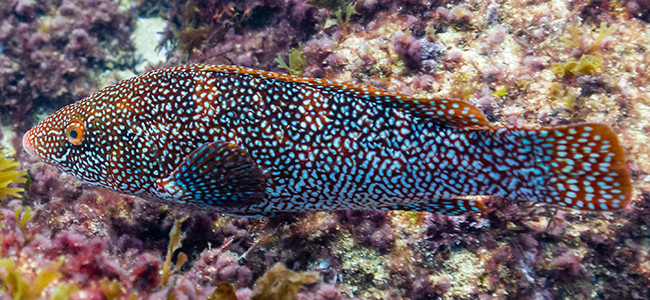Labrus bergylta, commonly known as the ballan wrasse, is a fish belonging to the family Labridae. The scientific name derives from the genus Labrus, which groups wrasses, and ‘bergylta‘, a term of Scandinavian origin that may be related to the characteristic coloration of this fish. It is distributed in the northeastern Atlantic waters, from Norway to the Canary Islands, including the coasts of the United Kingdom, France, Spain, and Portugal, and is also common in the Mediterranean Sea. Labrus bergylta primarily inhabits rocky coastal areas at depths ranging from 5 to 50 meters, where it finds shelter among rocks and seaweed.

Labrus bergylta is a robust fish with an elongated and somewhat laterally compressed body, measuring between 40 and 60 cm, although individuals up to 70 cm have been recorded. Its coloration is highly variable, depending on the environment and the age of the individual, generally ranging from green, brown, to reddish tones, with irregular spots that allow it to camouflage among algae and rocks. Juveniles tend to have lighter coloration, while adults develop darker tones and more defined patterns. Its mouth is large and equipped with strong teeth that allow it to crush the shells of molluscs and crustaceans, which make up most of its diet. Compared to similar species like Labrus mixtus (cuckoo wrasse), Labrus bergylta is distinguished by its larger size and a less bright, more uniform coloration.
Regarding its diet, Labrus bergylta is primarily carnivorous and feeds on a wide variety of benthic invertebrates. Its diet includes crustaceans, molluscs, sea urchins, and worms. Thanks to its powerful jaws and robust teeth, it can break the shells and carapaces of its prey, allowing it access to a wider variety of food than less specialized fish. It is an active hunter, searching for food among rocks and seaweed on the seabed where most of its prey is found.
Reproduction in Labrus bergylta occurs during spring and summer. It is an oviparous species, with males playing a key role in nest construction and protection. During the breeding season, males prepare nests among rocks and algae where females lay their eggs. After spawning, males care for the eggs by fanning and protecting them from predators until they hatch. This parental care behavior is typical of wrasses, which show protection of their young during early life stages.
An interesting fact about Labrus bergylta is its ability to change color depending on its emotional state or environmental conditions, which helps it camouflage and avoid predators. Additionally, this fish is known for its longevity, living up to 20 years. In some regions, such as Galicia and the British Isles, Labrus bergylta is valued for both recreational and commercial fishing, as its meat is appreciated for its flavor and firm texture. However, its capture must be done sustainably, since its slow growth and reproduction make it vulnerable to overfishing in some areas.
Photos:


 from
from